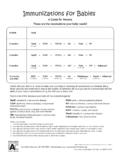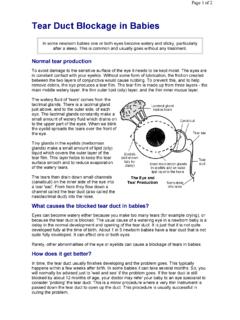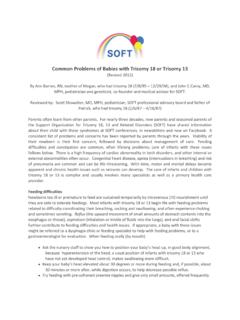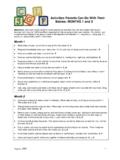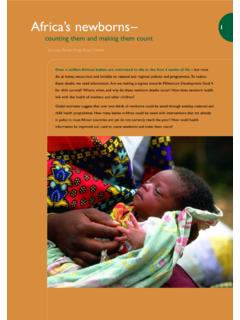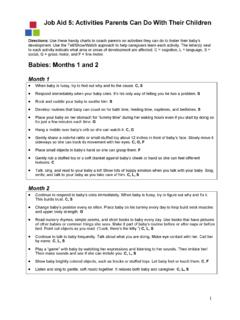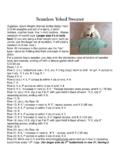Transcription of Caesarean birth: Psychological aspects in babies
1 Rien Verdult Journal of Prenatal and Perinatal Psychology and Medicine, 2009, 21,1/2, pg 29-41 Caesarean birth : Psychological aspects in babies Rien Verdult Psycholoog-babypsychotherapeut Summary: Caesarean birth can be seen as a traumatic birth for the baby with immediate and long term consequences. C-section is a trauma because of its abrupt and sudden interruption of the biologically programmed vaginal birth process. Shock, bonding deficiencies and invasion/control complex are the major symptoms of the trauma. Baby therapy is based on the new paradigm about prenatal and perinatal life. babies are aware before and during birth and can be traumatized. The treatment of Caesarean born babies consists of two aspects : regressively re-experiencing the traumatic aspects of the c-section and the processing of vaginal birth .
2 In exploring the traumatic aspects of the c-section so called trauma-sites are gently touched by the therapist. The baby can get activated and within the safety of a containing relationship, catharsis can take place. By supporting the baby to release his emotional pain the reprocessing of the c-section birth takes place in small steps. Baby have a knowledge about how they should have been born vaginally. Through a process of vaginal birth simulation the baby descends in the birth canal, rotates in the pelvis. Than the expulsion takes place and the baby ends up in the arms of his mother. Results of baby therapy show that babies benefit from the treatment. Keywords: Caesarean birth , psychology, trauma, baby psychotherapy Introduction: In the last half century hospital birth has become the standard birth and in the same period c-section rates have risen up to 25 65%.
3 Ironically birth has become more painful for babies . Pain-inflicting technological protocols of routine obstetrics are causing more traumatic births. Pain in babies is still denied (Chamberlain, 1999). Up to now many scientists and medical practitioners still believe that babies are born without an awareness and sensitivity about what is going on to their bodies and psyches; babies don t have any recollection of their prenatal life; babies are unable to experience what is going on during birth and no possible harm can be done to their emotional well being. From this point of view Caesarean birth is considered to be an easy and painless way of being born that has many advantages for both the mother and the baby. In the medical profession c-section is considered to be a Rien Verdult Journal of Prenatal and Perinatal Psychology and Medicine, 2009, 21,1/2, pg 29-41 safe, quick and routine surgery.
4 This attitude gives rise to the increasing c-section rates for which there are numerable additional non medical factors responsible (Verdult, 2009). Although Caesarean birth has physical disadvantages and risks, the possible traumatic aspects of c-section birth in babies are ignored and denied. Most parents seek help in baby psychotherapy because they have problems with their babies . Intensive crying, sleeping difficulties and eating problems are the most common symptoms. Most parents don t have any idea what causes these problems; most of the time they don t have any idea about the emotional pain the baby is suffering from; they are surprised when we speak about the traumatic aspects of their child s birth . Trauma in children and especially in babies is still not recognized.
5 Prenatal and perinatal psychology has shown differently. babies are aware, conscious, interactive and social human beings. Fetuses and babies can react to signals from their environment and can be traumatized by overwhelming input to their system. Through the work of pioneers like Thomas Verny (1981, 1992, 2002), David Chamberlain (1988) and William Emerson (1998ab) we now know that babies can experience emotional pain, anxiety, rage, loneliness or sadness during and after birth . We now know that c-section birth is a traumatic experience to the baby with immediate and long term consequences. Through thousands of years of human evolution (phylogenese) the human baby is being born through a narrow birth canal, which is developed out of a compromise between the narrowing pelvis of his mother enabling her upright position and the baby big head containing his human cortical brain (Janus, 1991).
6 The human baby is the only species on this planet that needs an internal rotation in the birth canal in order to be born. This makes birth difficult and painful. Both the mother s and the baby s body have biochemical options to ease this pain. birth is, in the words of Odent, a biochemical symphony, stating that we have biochemical solutions for this difficult process of entering the world. This birth process is biologically programmed in every baby. The baby knows when to activate his birth process, knows how to go through the birth canal, knows how to cooperate with his mother, and expects to end up in her arms. Any interruption of this process can be harmful, stressful or even traumatic to the baby. C-section birth is an abrupt and sudden interruption of this natural birth process.
7 It is not only a different doorway being used, but also a violation of the biological birth programme that is stored in the baby and activated during birth . Trauma happens when any experience is threatening the baby; it overwhelms the baby, leaving it disconnected from the body. Any coping mechanisms are undermined and the baby is in a state of helplessness and hopelessness. Modern trauma research has shown that trauma is not in the event itself, rather trauma resides in the nervous system (Levine & Kline, 2007). This is also the case for babies . As trauma resides in the nervous system, the body is not going to forget about trauma. Caesarean birth can be seen as a traumatic event for the baby who has only very Rien Verdult Journal of Prenatal and Perinatal Psychology and Medicine, 2009, 21,1/2, pg 29-41 limited coping skills to deal with the situation and this trauma is stored in his body leading to physical symptoms.
8 Physiological aspects of Caesarean birth . The technology of Caesarean delivery includes an array of interventions that are opposite to unmedicated natural birth . Odent (2004) stresses the importance of birth physiology. His thesis is: de-humanize birth and give priority to mammalianize childbirth. That is to say: what is specifically human, namely the neocortex must be eliminated, while the mammalian needs must be met. birth is a process that is not controlled by the neocortex but more by the mammalian brain, that is the limbic system. To state it even stronger: neocortical activities during the birth process should be reduced to the minimum and labouring women should be allowed to function from there limbic system. To feel secure in the surrounding where she is giving birth is a crucial factor for reducing the release of hormones of the adrenaline family so that the neocortex is not stimulated.
9 The labouring woman is allowed to withdraw in her own inner world where she can focus on her body and her emotions and not on external data. Privacy is a major condition. She is accompanied by a motherly, silent, low profile doula. In other words: to create conditions for an authentic foetus ejection reflex . According to Odent this reflex is the effect of a sudden spectacular reduction in the activity of the neocortex, making possible the release of a complex hormonal cocktail. During the reflex there is a short series of irresistible, uncontrollable contractions, while the labouring woman can be in the most unexpected postures. There is an sudden explosive release of oxytocin which makes birth , breastfeeding and bonding easier. The foetus ejection reflex is not seen in c-section. A Caesarean born baby is physiologically different from a baby born by the vaginal route.
10 More after- birth complications can be seen after c-section birth in comparison to vaginal birth . The lungs and heart do not work in the same way; they have lower Apgar-score, indicating physiological problems; the glucose levels tend to be lower (especially in non labour c-sections); the body temperature is lower in the first 90 minutes after birth . C-section babies show more respiratory problems and breathing difficulties: respiratory distress syndrome which is a major cause of neonatal death; serum protein and serum calcium are lower; due to less stimulation of the nervous system and the respiratory system, breathing and reflexes are slower. Caesarean babies need more aspirations. They have more difficulties in adaption to the changing environment due to lack of skin stimulation and hormonal exchange.


